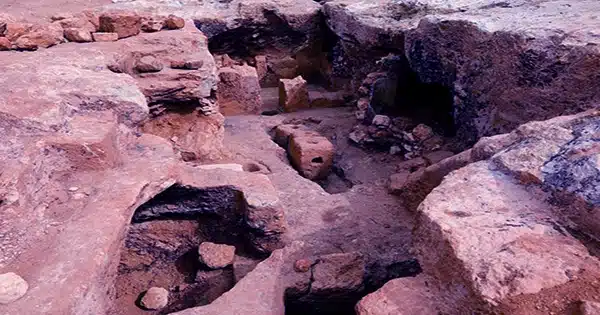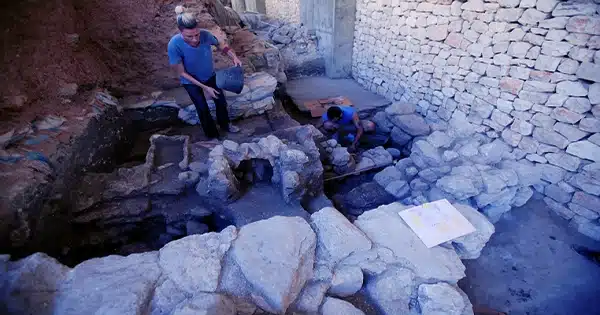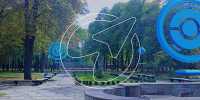Researchers from four Israeli universities—The Hebrew University of Jerusalem, Bar-Ilan University, Ariel University, and Tel Aviv University—have made a breakthrough that will make it possible for archaeologists to identify charred objects found during excavations and determine the temperature at which they were fired.
The Biblical story that Hazael King of Aram went up and assaulted Gath and took it about this time was confirmed by the researchers using their methodology on finds from ancient Gath (Tell es-Safi in central Israel). Subsequently, he shifted his focus to Jerusalem (2 Kings 12, 18). They clarify that in contrast to earlier approaches, the novel technique can ascertain whether a particular object—like a mud brick—underwent a burning event even at comparatively low temperatures, up to 200°C. This data may be essential for accurately interpreting the results.
Dr. Yoav Vaknin of the Sonia & Marco Nadler Institute of Archaeology, Entin Faculty of Humanities, Tel Aviv University, and the Palaeomagnetic Laboratory, The Hebrew University, led the multidisciplinary research. The article is now available on PLOS ONE.

Prof. Lipschits stated, “Mud bricks were the primary building material in most of the Land of Israel during the Bronze and Iron Ages. Most structures had walls constructed out of this easily accessible, reasonably priced material, sometimes even over stone foundations. It is crucial to comprehend the technology involved in the production of these bricks because of this.
“During that same era, people in other lands, like Mesopotamia, where stone was scarce, would fire mud bricks in kilns to increase their strength and durability,” Dr. Vaknin continued. Genesis’s account of the Tower of Babel mentions this method: “They said to one another, Come, let us make bricks and fire them thoroughly.”Accordingly, they substituted brick for stone (Genesis 11, 3).
The majority of experts, however, think that the Roman conquest—which occurred considerably later—is when this technology first arrived in the Land of Israel. The occupants employed sun-dried mud bricks up until that point. As a result, when bricks are discovered during an archaeological dig, several concerns need to be addressed. Firstly, did the bricks undergo a destructive combustion event in situ, or were they burned in a kiln before being built? Our approach can yield definitive results.”
The novel technique measures the magnetic field that was “locked” and recorded in the brick during its burning and cooling processes.
“Millions of ferromagnetic particles—minerals with magnetic properties that behave like so many tiny ‘compasses’ or magnets—are present in the clay from which the bricks were made,” Dr. Vaknin stated. These magnets’ nearly random orientation causes them to cancel each other out in a sun-dried clay brick.”
As a result, the brick’s overall magnetic signal is inconsistent and feeble. When heated to 200°C or more, as occurs during a fire, these magnetic particles emit their magnetic signals, which, in most cases, coincide with the earth’s magnetic field at that particular location and time. A magnetometer may be used to measure the strong, uniformly directed magnetic field that the brick achieves as it cools down since these magnetic signals are locked in place. This is unmistakably proof that the brick has been burned.”
In the second phase of the experiment, the scientists use a technique known as thermal demagnetization to progressively “erase” the magnetic field of the brick. To do this, the brick must be heated in a unique oven within a palaeomagnetic laboratory to neutralize the earth’s magnetic field.
The magnetic signals are released by the heat, and they randomly reorganize themselves once more, canceling each other out and making the overall magnetic signal weaker and less oriented.
“We conduct the process gradually,” stated Dr. Vaknin. To begin with, we heat the sample to 100°C, which only partially releases the magnetic mineral signals. After it has cooled, we measure the magnetic signal that is still present. The process is then repeated at 150°C, 200°C, and so on, increasing the temperature gradually to 700°C.”
The brick’s magnetic field is progressively eliminated in this way. The temperature at which each mineral’s signal is “unlocked” is about equal to the temperature at which it was first “locked,” and the original fire is ultimately responsible for the temperature at which the magnetic field is destroyed.”
In the lab, the researchers tested the method by firing mud bricks under carefully regulated temperature and magnetic field settings, measuring the magnetic field that each brick received, and then progressively erasing it. The bricks were discovered to be fully demagnetized at the burning temperature, indicating the effectiveness of the technique.
“Our approach enables the identification of burning which occurred at much lower temperatures than any other method,” stated Dr. Vaknin. The majority of methods for distinguishing burned bricks are based on real mineral alterations, which often take place at temperatures greater than 500°C and involve the transformation of some minerals into other types.”
“Changes in the absorption of infrared radiation by the various minerals are a common method for identifying mineralogical changes in clay (the main component of mud bricks) due to exposure to high temperatures,” Dr. Eliyahu Behar continued. This method was employed in this investigation as an extra tool to confirm the magnetic method’s findings.”
“Our method is much more sensitive than others because it targets changes in the magnetic signal’s intensity and orientation, which occur at much lower temperatures,” Dr. Vaknin continued. As low as 100°C, we can start to see changes in the magnetic signal, and the results become definitive around 200°C and above.”
Furthermore, the technique can ascertain in which direction the bricks cooled. According to Dr. Vaknin, “A brick records the direction of the earth’s magnetic field at a particular moment and place when it is burnt in a kiln before construction. This implies north and downward in Israel. However, the recorded signals are randomized when wall builders use bricks laid in various orientations straight out of a kiln to construct a wall.”
“On the other hand, when a wall is burned in situ, as might happen when it is destroyed by an enemy, the magnetic fields of all bricks are locked in the same orientation.”
Once the method’s viability was established, the researchers applied it to an archaeological controversy: was a certain brick edifice found at Tell es-Safi—which has been identified as the Philistine city of Gath, the home of Goliath—constructed from pre-fired bricks or burned on site? The prevailing theory, supported by the Old Testament, historical accounts, and Carbon-14 dating, links the building’s collapse to Hazael, King of Aram Damascus’s destruction of Gath in 830 BCE.
In contrast, a previous study by scholars led by Prof. Maeir, the head of the Tell es-Safi excavations, suggested that the building had collapsed over decades rather than burning down and that the bricks recovered within had been burnt in a kiln before they were built. This would be the first known example of brick-firing technology found in the Land of Israel if this theory is right.
To resolve the disagreement, samples from the Tell es-Safi wall and the collapsed debris discovered next to it were subjected to a novel procedure by the current study team.
The results were unambiguous: all bricks and fallen debris had magnetic fields that were oriented north and downward. According to Dr. Vaknin, “Our results indicate that the bricks burned and cooled down in situ, in the structure itself—that is, in a conflagration that occurred within a few hours.” The bricks’ magnetic orientations would have been random if they had been burned in a kiln before being placed in the wall.”
Furthermore, the crumbling debris would have shown varied magnetic orientations if the structure had collapsed gradually rather than all at once during a single fire incident. We think that the incapacity of our colleagues to distinguish burns at temperatures lower than 500°C was the primary cause of their incorrect judgment. The previous investigation did not identify the components at the bottom of the structure as burned since heat rises and they burned at relatively low temperatures, below 400°C. This led to the conclusion that the building had not been destroyed by fire.”
The researchers deduced that the bricks in the higher regions of the wall, which saw elevated temperatures, had been fired in a kiln before construction because of the mineralogical alterations that occurred in those areas and the subsequent identification of burned bricks. Using our approach, we were able to ascertain that every brick in the wall and the debris had burned during the conflagration: the bricks at the bottom burned at comparatively moderate temperatures, while the bricks discovered in upper layers or that had fallen from the top burned at temperatures above 600°C.”
Prof. Maeir stated, “Our findings are very important for understanding the building methods prevailing in that era as well as deciphering the intensity of the fire and scope of destruction at Gath, the largest and most powerful city in the Land of Israel at the time.” Reviewing prior research findings and perhaps challenging preexisting interpretations is crucial, especially if they originate from your university.”
Prof. Ben-Yosef continued, saying that “old building techniques have significant ecological ramifications in addition to their historical and archeological relevance. Large amounts of combustible materials are needed for brick firing technique, which may have historically resulted in significant deforestation and even the extinction of local tree species.”
For instance, several tree and shrub species that were formerly heavily utilized by the Timna Valley’s ancient copper mine have never fully recovered, and the business itself finally failed when its natural fuel supplies ran out. Our research suggests that during the reigns of Judah and Israel, the brick firing technique was most likely not used in the Land of Israel.”
Professor Ron Shaar of The Hebrew University’s Institute of Earth Sciences, Professors Erez Ben-Yosef and Oded Lipschits of Tel Aviv University’s Sonia & Marco Nadler Institute of Archaeology, Professor Aren Maeir of Bar-Ilan University’s Martin (Szusz) Department of Land of Israel Studies and Archaeology, and Dr. Adi Eliyahu Behar of Ariel University’s Department of Land of Israel Studies and Archaeology and Department of Chemical Sciences are among the other contributors.















